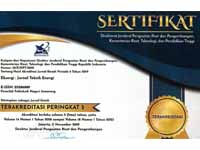Validation Insulation Resistance Testing and Reliability Assessment of 6 kV Current Transformers for High Voltage Applications
DOI:
https://doi.org/10.32497/eksergi.v21i01.6357Keywords:
Pressure transmitter, I/O loop testing, analog signal, HART communication, hybrid validation, error analysisAbstract
Current transformers (CTs) are critical components in electrical power systems, particularly for measurement and protection functions in high-voltage systems. However, the performance and operational safety of CTs heavily depend on the quality of their insulation. A common issue encountered is insulation degradation due to aging, humidity, or external disturbances, which can lead to system faults or even complete equipment failure. This study aims to evaluate the insulation condition of a 6 kV CT through insulation resistance testing. The method employed involves measuring the insulation resistance using a megohmmeter with a direct current (DC) test voltage, where resistance values are recorded in megaohms (MΩ) up to gigaohms (GΩ). The test results showed an average resistance value of 145.5 GΩ, significantly exceeding the minimum threshold of 1 MΩ per kilovolt as stipulated in international standards (VDE 228/4). Therefore, it can be concluded that the CT insulation is in excellent condition and is reliably suitable for operation in high-voltage systems.
References
[1] S. Khan, T. Mazhar, T. Shahzad, M. Amir, A. U. Rehman, and H. Hamam, “Integration of Smart Grid with Industry 5.0: Applications, Challenges and Solutions, Measurement: Energy,” Meas. Energy, p. 100031, 2024, doi: 10.1016/j.meaene.2024.100031.
[2] H. Zahid, A. Zulfiqar, M. Adnan, and S. Iqbal, “Results in Engineering Review article A review on socio-technical transition pathway to European super smart grid : Trends , challenges and way forward via enabling technologies,” Results Eng., vol. 25, no. December 2024, p. 104155, 2025, doi: 10.1016/j.rineng.2025.104155.
[3] A. Hossain and L. Zhang, “Investigate the implementation of smart grid-integrated renewable distributed generation for sustainable energy development in Bangladesh,” Energy Reports, vol. 13, no. February, pp. 2433–2453, 2025, doi: 10.1016/j.egyr.2025.01.083.
[4] D. Hendrawati, B. W. Dionova, Sahid, J. Mukhlis, and A. Khoryanton, “Design of Wind Turbines Power Coefficient On Wind Farm Based Centralized Control,” 2021 Int. Semin. Intell. Technol. Its Appl., vol. 7, pp. 315–318, 2021.
[5] L. Tightiz, L. M. Dang, S. Padmanaban, and K. Hur, “Metaverse-driven smart grid architecture,” Energy Reports, vol. 12, no. August 2024, pp. 2014–2025, 2025, doi: 10.1016/j.egyr.2024.08.027.
[6] L. M. N. Gabriel, J. A. Adebisi, L. N. P. Ndjuluwa, and D. K. Chembe, “Franklin Open Investigation of smart grid technologies deployment for energy reliability enhancement in electricity distribution networks,” vol. 10, no. September 2024, 2025.
[7] M. E. Aguida, Y. Che, and J. Yang, “Technological advancements and future prospects of electrical power systems for sustainable more electric aircraft,” Propuls. Power Res., vol. 13, no. 4, pp. 475–486, 2024, doi: 10.1016/j.jppr.2024.11.003.
[8] S. U. Ercan, “Power line Communication: Revolutionizing data transfer over electrical distribution networks,” Eng. Sci. Technol. an Int. J., vol. 52, no. August 2023, p. 101680, 2024, doi: 10.1016/j.jestch.2024.101680.
[9] T. Al, K. S. Gaeid, A. T. Mahmood, and R. J. Hussein, “Results in Engineering State space modeling and control of power plant electrical faults with neural networks for diagnosis,” Results Eng., vol. 25, no. February, p. 104582, 2025, doi: 10.1016/j.rineng.2025.104582.
[10] J. Riba, A. Garcia, S. Trujillo, and A. Marz, “Systems Analyzing the temperature and frequency dependence of eddy currents in transformer windings,” Int. J. Electr. Power Energy, vol. 159, no. January, 2024, doi: 10.1016/j.ijepes.2024.110053.
[11] D. Naumovic-vukovic and S. Skundric, “Measurement : Sensors,” Meas. Sensors, no. xxxx, p. 101428, 2024, doi: 10.1016/j.measen.2024.101428.
[12] H. Athari and D. Raisz, “Converter-based multi-frequency power transfer system for efficient energy packet transmission in the energy internet,” Energy Reports, vol. 12, no. June, pp. 2690–2706, 2024, doi: 10.1016/j.egyr.2024.08.061.
[13] F. Xu and G. Peng, “Internet infrastructure , digital development and urban energy ef fi ciency,” J. Digit. Econ., vol. 3, no. November, pp. 62–74, 2024, doi: 10.1016/j.jdec.2024.11.001.
[14] S. Nilakanta, K. Borah, and S. Chatterjee, “Results in Optics Review on monitoring of transformer insulation oil using optical fiber sensors,” Results Opt., vol. 10, no. December 2022, p. 100361, 2023, doi: 10.1016/j.rio.2023.100361.
[15] P. Pagoni, B. M. Eva, and R. H. Peuhkuri, “Energy & Buildings Decisive parameters for moisture safe internal insulation of masonry − Long time monitoring in inhabited dwellings,” vol. 312, no. October 2023, 2024, doi: 10.1016/j.enbuild.2024.114180.
[16] I. Masalha, S. Ujila, O. Badran, and A. Alahmer, “A multi-method approach to investigating porous media cooling for enhanced thermal performance of photovoltaic panels : Exploring the effects of porosity , flow rates , channel design , and coolant types,” Int. J. Thermofluids, vol. 27, no. March, p. 101165, 2025, doi: 10.1016/j.ijft.2025.101165.
[17] A. J. Werner-Juszczuk and A. Siuta-Olcha, “Assessment of the impact of setting the heating curve on reducing gas consumption in a residential building while ensuring thermal comfort,” J. Build. Eng., vol. 94, no. June, p. 110032, 2024, doi: 10.1016/j.jobe.2024.110032.
Downloads
Published
Issue
Section
License
Copyright (c) 2025 Suwarti Suwarti, Natanael Yonando Hermawan, Amrisal Kamal Fajri, Langga Samaratungga

This work is licensed under a Creative Commons Attribution 4.0 International License.
Authors who publish with this journal agree to the following terms:Authors retain copyright and grant the journal right of first publication with the work simultaneously licensed under a Creative Commons Attribution License that allows others to share the work with an acknowledgement of the work's authorship and initial publication in this journal.
Authors are able to enter into separate, additional contractual arrangements for the non-exclusive distribution of the journal's published version of the work (e.g., post it to an institutional repository or publish it in a book), with an acknowledgement of its initial publication in this journal.
Authors are permitted and encouraged to post their work online (e.g., in institutional repositories or on their website) prior to and during the submission process, as it can lead to productive exchanges, as well as earlier and greater citation of published work (See The Effect of Open Access).






